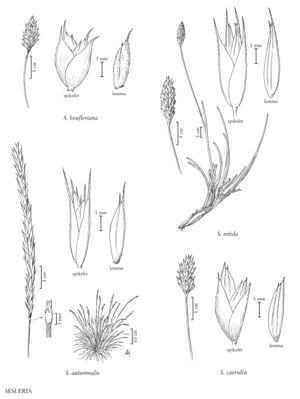Sesleria heufleriana
Plants cespitose, not rhizomatous, rarely stoloniferous, green when young, becoming glaucous and blue in early summer. Culms 25-80(100) cm; exposed nodes 1-2. Leaves mostly basal; sheaths glabrous; ligules 0.2-0.5 mm, ciliate; blades of cauline leaves 0.8-5 cm long, 2-4(5.5) mm wide, acute or acuminate; blades of flag leaves 1-2.1 cm. Panicles (1)1.5-4(8) cm long, 7-11 mm wide, dense, ovoid to cylindrical. Spikelets 3-6 mm, with 2^1 florets, glaucous. Glumes 3-4 mm, ovate-lanceolate, coriaceous, sparsely ciliate on the veins and margins, 1-veined, narrowing to 0.5-2.5 mm awnlike apices; lemmas 3-4 mm, ovate to elliptic, pubescent, apices awned and toothed, central veins terminating in a 1-4 mm awn, lateral veins forming teeth shorter than 1 mm; paleas 3-5 mm, hairy, 2-awned, awns 0.2-1.5 mm; anthers about 4 mm. 2n = unknown.
Discussion
Sesleria heufleriana is native to east-central Europe, where it grows in woods and on rocks, usually over calcareous substrates. It is grown as an ornamental in the Flora region.
Selected References
None.
